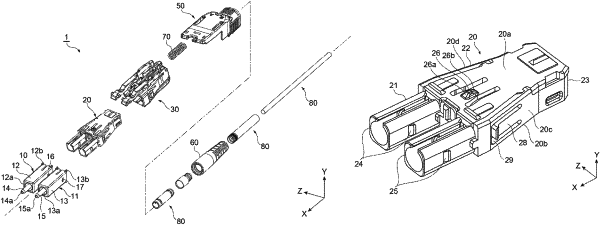| CPC G02B 6/3893 (2013.01) [G02B 6/3858 (2013.01); G02B 6/3878 (2013.01)] | 10 Claims |

|
1. An optical connector which has a front end and a rear end opposite to the front end in a first direction, and into which first and second optical fibers are insertable from the rear end, the connector comprising:
first and second ferrules holding the first and second optical fibers respectively;
first and second front housings each accommodating a corresponding ferrule of the first and second ferrules inside;
an inner housing connected to rear ends of the first and second front housings;
an outer housing including a first latch which protrudes toward the front end along the first direction and of which a tip portion is configured to be engageable with an external device, the outer housing accommodating the inner housing inside; and
a tab disposed in a second direction intersecting the first direction with respect to the outer housing, the tab being configured to move rearward along the first direction with respect to the outer housing to release a state of engagement between the first latch and the external device,
wherein the inner housing is configured to be insertable into and extractable from the outer housing in the first direction such that a polarity of the first and second front housings is changeable, by rotating 180° around a central axis along the first direction with respect to the outer housing,
the inner housing includes second latches that are disposed on first and second side portions respectively, the first and second side portions are arranged in a third direction intersecting both the first direction and the second direction, and the second latches are exposed from the tab,
the second latches include respective engaging portions that are engageable with the outer housing to restrict an extraction of the inner housing from the outer housing,
each of the engaging portions is configured to be elastically pushable toward an inside of the inner housing, and
each of the engaging portions is pushed toward the inside of the inner housing to release a state of engagement between the inner housing and the outer housing.
|